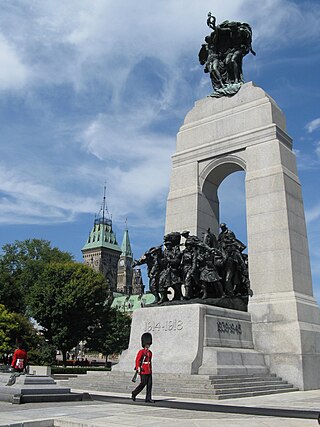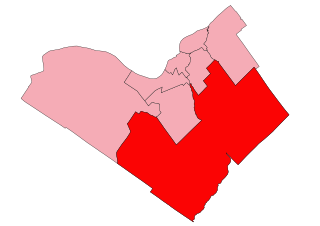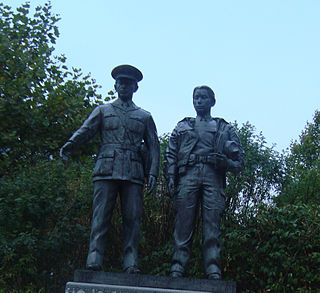 The monument in 2015 | |
 | |
| 43°39′45.2″N79°23′34.1″W / 43.662556°N 79.392806°W |
A statue of William Lyon Mackenzie is installed in Toronto's Queen's Park, in Ontario, Canada. [1]
 The monument in 2015 | |
 | |
| 43°39′45.2″N79°23′34.1″W / 43.662556°N 79.392806°W |
A statue of William Lyon Mackenzie is installed in Toronto's Queen's Park, in Ontario, Canada. [1]
The front features a bust of Mackenzie from his chest to head, 1.2 metres (3.9 ft) high, 70 centimetres (28 in) wide, and 45 centimetres (18 in) thick. [2] Behind the bust is a bronze tableau that is 6.35 metres (20.8 ft) long, 88 centimetres (35 in) wide, and 1 metre (3.3 ft) tall, which runs parallel to the legislative building. [3] On one end of the tableau stands a toga-clad, bent human figure standing 2.45 metres (8.0 ft) tall clutching a law book. [2]

William Lyon Mackenzie King was a Canadian statesman and politician who was the tenth prime minister of Canada for three non-consecutive terms from 1921 to 1926, 1926 to 1930, and 1935 to 1948. A Liberal, he was the dominant politician in Canada from the early 1920s to the late 1940s. King is best known for his leadership of Canada throughout the Great Depression and the Second World War. He played a major role in laying the foundations of the Canadian welfare state and establishing Canada's international position as a middle power. With a total of 21 years and 154 days in office, he remains the longest-serving prime minister in Canadian history.

William Lyon Mackenzie was a Scottish Canadian-American journalist and politician. He founded newspapers critical of the Family Compact, a term used to identify elite members of Upper Canada. He represented York County in the Legislative Assembly of Upper Canada and aligned with Reformers. He led the rebels in the Upper Canada Rebellion; after its defeat, he unsuccessfully rallied American support for an invasion of Upper Canada as part of the Patriot War. Although popular for criticising government officials, he failed to implement most of his policy objectives. He is one of the most recognizable Reformers of the early 19th century.

The Upper Canada Rebellion was an insurrection against the oligarchic government of the British colony of Upper Canada in December 1837. While public grievances had existed for years, it was the rebellion in Lower Canada, which started the previous month, that emboldened rebels in Upper Canada to revolt.

The Family Compact was a small closed group of men who exercised most of the political, economic and judicial power in Upper Canada from the 1810s to the 1840s. It was the Upper Canadian equivalent of the Château Clique in Lower Canada. It was noted for its conservatism and opposition to democracy.

Queen's Park is an urban park in Downtown Toronto, Ontario, Canada. Opened in 1860 by Edward, Prince of Wales, it was named in honour of Queen Victoria. The park is the site of the Ontario Legislative Building, which houses the Legislative Assembly of Ontario. The phrase "Queen's Park" is regularly used as a metonym for the Government of Ontario or the Legislative Assembly of Ontario.

Events from the year 1894 in Canada.

Queenston is a compact rural community and unincorporated place 5 kilometres (3.1 mi) north of Niagara Falls in the Town of Niagara-on-the-Lake, Ontario, Canada. It is bordered by Highway 405 to the south and the Niagara River to the east; its location at the eponymous Queenston Heights on the Niagara Escarpment led to the establishment of the Queenston Quarry in the area. Across the river and the Canada–US border is the village of Lewiston, New York. The Lewiston-Queenston Bridge links the two communities. This village is at the point where the Niagara River began eroding the Niagara Escarpment. During the ensuing 12,000 years the Falls cut an 11 kilometres (6.8 mi) long gorge in the Escarpment southward to its present-day position.

Cinesphere is the world's first permanent IMAX movie theatre, located on the grounds of Ontario Place in Toronto, Ontario, Canada. Constructed in 1971, it is the largest IMAX theatre in Ontario. The theatre has both IMAX 70mm and IMAX with Laser projection systems. The theatre is considered a building of heritage value and shows movies each weekend. It is owned by the Government of Ontario, which owns the entire Ontario Place site.

The National War Memorial, titled The Response, is a tall, granite memorial arch with accreted bronze sculptures in Ottawa, Ontario, designed by Vernon March and first dedicated by King George VI in 1939. Originally built to commemorate the Canadians who died in the First World War, it was in 1982 rededicated to also include those killed in the Second World War and Korean War and again in 2014 to add the dead from the Second Boer War and War in Afghanistan, as well as all Canadians killed in all conflicts past and future. It now serves as the pre-eminent war memorial of 76 cenotaphs in Canada. In 2000, the Tomb of the Unknown Soldier was added in front of the memorial and symbolizes the sacrifices made by all Canadians who have died or may yet die for their country.
Algoma was an electoral riding in Ontario, Canada. It was created in 1867 at the time of confederation. In 1885 it was split into two: Algoma East and Algoma West. In 1902 it was re-established as a single riding and was abolished in 1933 before the 1934 election. In 1967 it was re-established a second time and lasted until 1999 when it was merged into Algoma—Manitoulin.

By the arrangements of the Canadian federation, Canada's monarchy operates in Ontario as the core of the province's Westminster-style parliamentary democracy. As such, the Crown within Ontario's jurisdiction may be referred to as the Crown in Right of Ontario, His Majesty in Right of Ontario, the King in Right of Ontario, or His Majesty the King in Right of Ontario. The Constitution Act, 1867, leaves many functions in Ontario specifically assigned to the sovereign's viceroy, the lieutenant governor of Ontario, whose direct participation in governance is limited by the constitutional conventions of constitutional monarchy.

The Adam Beck Memorial is a memorial in Toronto, Ontario, Canada in honour of the founder of Ontario Hydro, Sir Adam Beck. It is located in the landscaped median of University Avenue just south of Queen Street West. Designed by sculptor Emanuel Hahn, the monument was the first place entry in a design competition for a memorial to commemorate Adam Beck. It was unveiled in 1934.

Carleton is a provincial riding in Ontario, Canada. It was created in 1867 at the time of confederation and lasted until provincial redistribution in 1996. In the 1999 provincial election it was redistributed into Nepean—Carleton and Lanark—Carleton. In 2007 it was abolished into Carleton—Mississippi Mills and Lanark—Frontenac—Lennox and Addington.

Coronation Park is a park and veteran's memorial in Toronto, Ontario, built to mark the coronation of King George VI in 1937. Most trees are planted to honour the Canadian men and women who participated in the First World War and earlier wars, while others commemorate subsequent coronations of Canadian monarchs. Constructed on landfill on the shore of Lake Ontario during the Great Depression, many workers on relief were used. The park also has the Victory-Peace monument, located at the water's edge. To the east is HMCS York, the naval barracks; to the north is Fort York and the Fort York Armoury; and, to the west, is Exhibition Place, once the site of New Fort York.
Walter Yarwood was a Canadian abstract painter and a founding member of Painters Eleven. Yarwood became known for his painting beginning in the 1950s. During the 1960s he completed a number of public sculptures in Ontario, Quebec and Manitoba.

The Northwest Rebellion Monument is a memorial installed in Toronto's Queen's Park, in Ontario, Canada.

The Ontario Police Memorial is located in Toronto's Queen's Park, in Ontario, Canada. The monument was dedicated in 2000.

The Post One Monument in Toronto's Queen's Park commemorates Canada's centennial. Unveiled in 1967, the monument functions as a geodetic survey marker and has a time capsule that is slated to be opened in 2067.

The Canadian Volunteer Monument is installed in Toronto's Queen's Park, in Ontario, Canada. The memorial was dedicated in 1870.

The 48th Highlanders of Canada Regimental Memorial is a monument in Toronto's Queen's Park, in Ontario, Canada. The monument was erected in 1923.